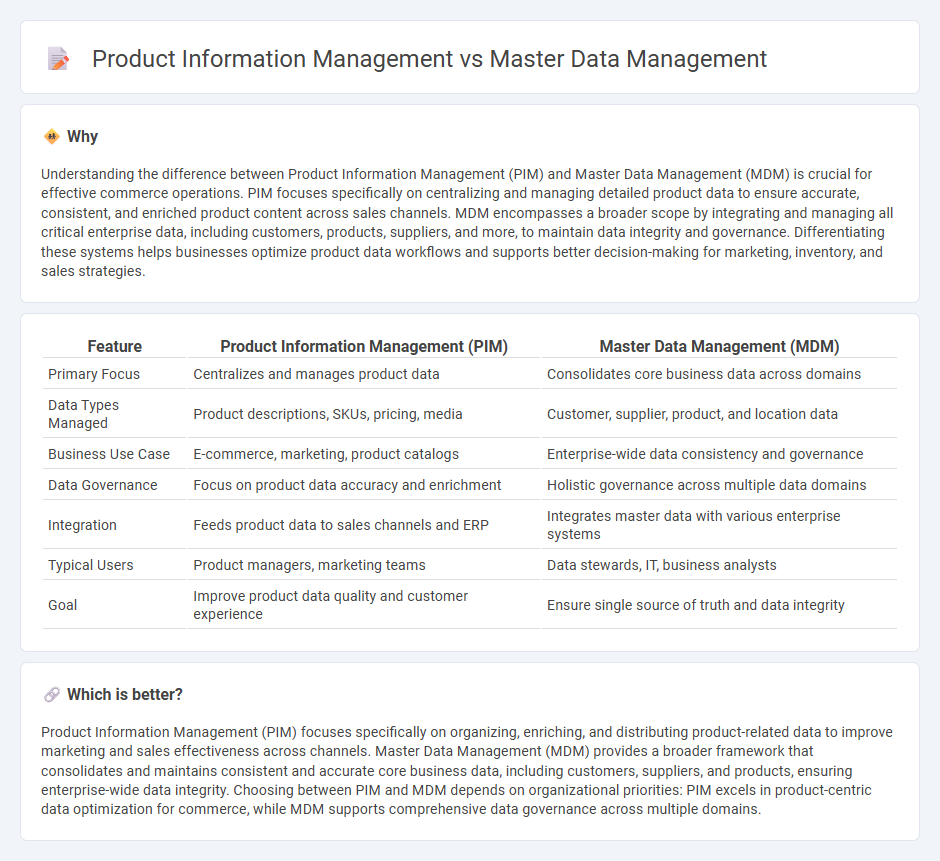
Product Information Management (PIM) centralizes and enriches product data to ensure consistent and accurate product representation across all sales channels. Master Data Management (MDM) encompasses a broader scope by unifying and maintaining key business data entities, including products, customers, and suppliers, to create a single source of truth. Explore the differences and benefits of PIM and MDM to optimize your data strategy.
Why it is important
Understanding the difference between Product Information Management (PIM) and Master Data Management (MDM) is crucial for effective commerce operations. PIM focuses specifically on centralizing and managing detailed product data to ensure accurate, consistent, and enriched product content across sales channels. MDM encompasses a broader scope by integrating and managing all critical enterprise data, including customers, products, suppliers, and more, to maintain data integrity and governance. Differentiating these systems helps businesses optimize product data workflows and supports better decision-making for marketing, inventory, and sales strategies.
Comparison Table
| Feature | Product Information Management (PIM) | Master Data Management (MDM) |
|---|---|---|
| Primary Focus | Centralizes and manages product data | Consolidates core business data across domains |
| Data Types Managed | Product descriptions, SKUs, pricing, media | Customer, supplier, product, and location data |
| Business Use Case | E-commerce, marketing, product catalogs | Enterprise-wide data consistency and governance |
| Data Governance | Focus on product data accuracy and enrichment | Holistic governance across multiple data domains |
| Integration | Feeds product data to sales channels and ERP | Integrates master data with various enterprise systems |
| Typical Users | Product managers, marketing teams | Data stewards, IT, business analysts |
| Goal | Improve product data quality and customer experience | Ensure single source of truth and data integrity |
Which is better?
Product Information Management (PIM) focuses specifically on organizing, enriching, and distributing product-related data to improve marketing and sales effectiveness across channels. Master Data Management (MDM) provides a broader framework that consolidates and maintains consistent and accurate core business data, including customers, suppliers, and products, ensuring enterprise-wide data integrity. Choosing between PIM and MDM depends on organizational priorities: PIM excels in product-centric data optimization for commerce, while MDM supports comprehensive data governance across multiple domains.
Connection
Product Information Management (PIM) centralizes detailed product data like descriptions, specifications, and images, ensuring consistency across sales channels. Master Data Management (MDM) governs the overall quality, accuracy, and synchronization of core business entities, including product data, customers, and suppliers. PIM operates as a specialized subset within MDM, focusing on product-centric data to enhance commerce efficiency and improve customer experience.
Key Terms
Centralized Data Repository
Master data management (MDM) centralizes critical business data such as customer, supplier, and product information to ensure consistency and accuracy across the enterprise. Product information management (PIM) specifically focuses on consolidating, managing, and enriching product-related data for marketing and sales channels. Explore how integrating MDM and PIM strategies can enhance your centralized data repository efficiency.
Data Quality
Master data management (MDM) centralizes critical business data across an organization to ensure consistency, accuracy, and accountability, with a strong emphasis on data quality standards and governance. Product information management (PIM) specifically targets product data, enhancing completeness, enrichment, and accuracy to improve product listings and customer experiences. Explore how optimizing data quality in both MDM and PIM drives better decision-making and operational efficiency.
Product Catalog
Master Data Management (MDM) centralizes and harmonizes critical business data across an organization, ensuring data consistency and accuracy, while Product Information Management (PIM) specifically focuses on managing detailed product attributes, descriptions, and digital assets to enhance the product catalog's quality. PIM systems optimize product catalog management by enabling seamless integration, enriched product content, and streamlined updates across multiple sales channels. Explore how leveraging both MDM and PIM can transform your product catalog strategy for improved customer experience and operational efficiency.
Source and External Links
What is Master Data Management? - IBM - Master Data Management (MDM) is a discipline and technology that integrates data from multiple sources to create a unified, accurate "golden record" of critical enterprise data like customers and products, ensuring data consistency and eliminating duplication across systems.
What is Master Data Management (MDM)? Definition from TechTarget - MDM is a process for creating uniform, consistent data sets on business entities such as customers and products across IT systems, improving data quality enterprise-wide and enabling trustworthy analytics and streamlined data sharing.
What is Master Data Management (MDM)? | Informatica - MDM involves creating a single, de-duplicated, reconciled, and enriched master record for key business entities, supported by automated technology and data governance to provide trusted, authoritative data shared across the organization for better decision-making.
 dowidth.com
dowidth.com